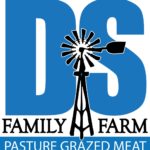Worried about what you are "really" eating? Have peace of mind with pasture grazed meats.
Plastic In Beef
Over the past few years, concerns have arisen about microplastics in food and within our bodies. Policies are being promoted for eliminating plastic pollution by 2040. Hopefully, you will consider the concerns and options you have to help reduce this potential environmental toxin before 2040.
Convenience of Plastic
Let’s face it, plastics provide services and convenience. It may be time to think about the consequences of plastics in our environment versus the service it provides. Many times, we can find an alternative to plastic, but again, we should consider the tradeoffs to each choice we make.
We utilize the regenerative agriculture practice of bale grazing in applying planned disruption to our pastures. In this process, we utilize large round bales. All of our round bales are made by a custom hay operator, we do not own a large round baler. The round bales are made with a plastic “bale wrap”. The plastic wrap does a great job of keeping the bale intact and preserving the hay from weathering.
What would be an alternative to plastic net wrapping? Natural sisal twine has been used for a long time in tying up bales. The downside to twine is that it doesn’t provide full coverage of the bale as shown in the “net” wrap above. Twine today is also sometimes treated with pesticides to prevent insect and rodent chewing.
Do Cattle Eat The Plastic Net Wrap?
While bale grazing on pasture, we like to set the bales on edge as shown above. This makes it fairly easy to cut the wrap and unwrap the bale before feeding. We also take some time to either distribute the bale in the area using a silage fork or place a round bale feeder around the bale, depending on our objective for the feed and the impact on the pasture. So in our situation, the plastic wrap is not ingested by our cattle.
Sadly, industrial beef eat plastic net wrap
I have heard of reports where confined animal feeding operations (CAFOs) do not take the time to remove the plastic net wrap before grinding wrapped bales for feeding. Veterinarians on Twitter/X indicate they have dealt with cattle on farms when bales were fed without removing the net wrap.
Unfortunately, we live in a time where doing the work to ensure animal welfare and health is compromised in the name of “cheap food” and “efficiency”. This past week, as I drove by a local CAFO, I witnessed firsthand plastic net-wrapped bales being ground up, with the plastic wrap, in preparation for feeding. The operation consisted of a tub grinder with a grapple, dropping plastic net wrap bales into the grinder, with processed hay and plastic coming off the conveyor belt.
With the convenience, efficiency, and automation of tub gridnders, it would seem that these operations could spend an extra few minutes per bale to remove the plastic net wrap prior to grinding. This would probably require another employee to slice off the net wrap, but this would be a small price to pay to prevent plastics from directly entering our food supply and improve animal health and welfare.
Consumer awareness
As we have tried to communicate over the years, we hope you take the time to do your research when it comes to the food you consume. We encourage you to find a local farm that raises food the way you would like it raised. I know there are plastics used in vegetable production also, so take the time to do your research on the pros and the cons involved.







